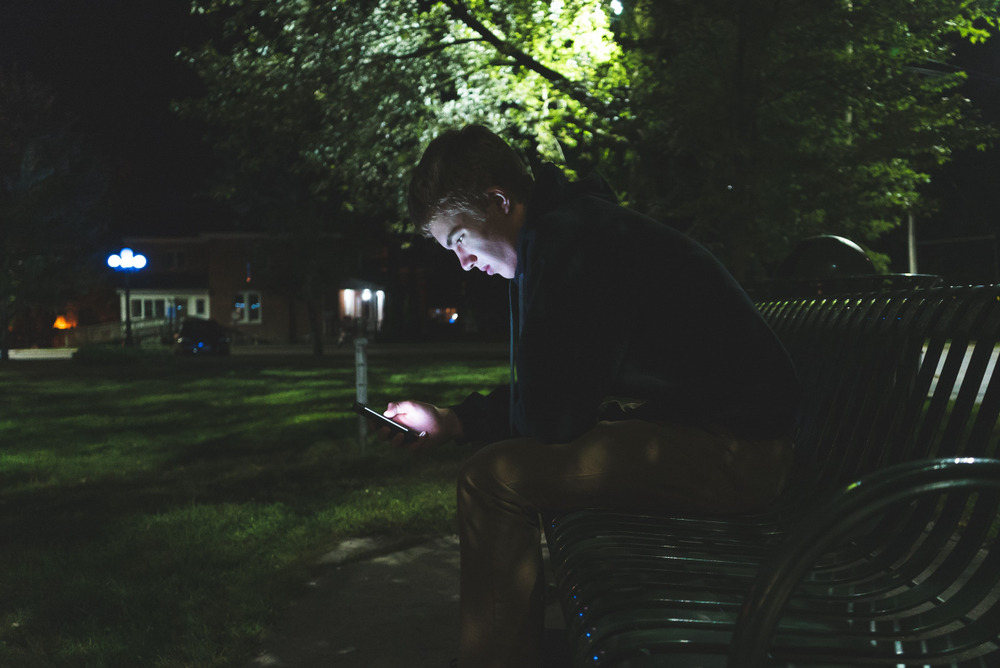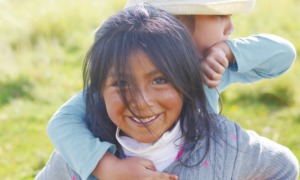
mooremedia/Shutterstock
.
Javier seems like a well-adjusted teenager on the surface. He’s gregarious, funny, sometimes brutally blunt and also a bit awkward. When the 18-year-old struggles to find words, he gazes towards his shoes and visibly retreats inside a chocolate brown hoodie.
But Javier has suffered unspeakable damage. Fearing ridicule from his peers and scorn from his caseworker (she says he has ignored her), he only agreed to talk for this story if key details of his life, including his name, were changed.
The Santa Fe youth has been in and out of New Mexico’s state systems for most of his life, due to a family history that he describes as “chaotic and violent.” He’s not enrolled in school and he says he has no plans to go back anytime soon to earn his high school diploma or even his general education degree.
Javier is also homeless, though he doesn’t match the profile of how people think of the homeless. He also doesn’t fit into the federal definition of homelessness, one that often drives policy at the local level. Child welfare experts say that housing instability is the number one destabilizer for an at-risk youth, especially for someone like Javier, who has run away from foster care and been in and out of the juvenile justice system.
A 2018 U.S. Interagency Council on Homelessness report shows that volatile housing is a driver for some of the poorest outcomes for kids, ranging from mental health and substance abuse issues to depression and suicidal behaviors. (New Mexico leads the country in teen suicide.) Child welfare experts say that homeless youth, who sometimes would rather live on the street or in a motel instead of an adult shelter, are often on a fast track to adult homelessness.
Vulnerable youth are also susceptible to falling into predatory human and sex trafficking rings or landing in prison. According to the Coalition for Juvenile Justice, a staggering 78% of runaway or homeless youth in 11 U.S. cities — predominantly people of color and LGBTQ individuals — had experienced police interaction.
More often than not, solutions for a particular city’s homeless crisis are targeted at adult and veteran populations. While that’s a positive, critics say that youth in care and other at-risk teens, who have found themselves particularly defenseless against the COVID-19 pandemic, are often snubbed.
During a March 19 virtual town hall for older foster youth, which functioned as an online welfare check for youth in state systems in the wake of the coronavirus, Jerry Milner, associate commissioner of the U.S. Children’s Bureau, said that many of the 20,000 youth who annually age out of foster care aren’t transitioning to permanent housing or supportive family situations.
“That’s an unacceptable injustice,” Milner said. “Frankly, it should not take a pandemic for us to reach out and ask how everything is going.”
Youth Homelessness Statistics Aren’t Thorough
Inaccurate or incomplete counts of homeless youth are also hurting vulnerable kids, critics say. “We have all of these different ways of counting homelessness and none of them are all that great,” said Hank Hughes, executive director of the Santa Fe-based New Mexico Coalition to End Homelessness.

Georgia State University
Eric Wright
Eric Wright, chair of the department of sociology and a professor of sociology and public health at Georgia State University in Atlanta, adds that there aren’t any states that specifically track youth in care who are experiencing homelessness.
“Some foster care systems will try to track them after they leave foster care, but they’re so under-resourced that they don’t do a good job,” Wright said. “It’s hard enough to manage the kids that they do have in their care.”
The two federal departments charged with compiling youth homelessness statistics — the U.S. Department of Housing and Urban Development (HUD) and the U.S. Department of Education (ED) — aren’t always on the same page. A December 2019 HUD release concluded that nationwide youth homelessness is on the decline. However, a January report by the University of North Carolina at Greensboro’s National Center for Homeless Education Program, which compiled ED statistics, showed a 15% jump in public school students who are housing insecure.
The longstanding definition of homelessness is determined by HUD, which asks municipalities to count all the homeless people they can find living on the streets on a certain day every other January. But the 24-hour Point in Time Count is flawed “because people use different methodologies,” Hughes said, “and you can’t find all of the homeless people in one night,” resulting in a massive undercount.

Steve Johnson
Due to its stringent classification, HUD-funded services are nearly inaccessible to transition-aged foster youth between 17 and 24 years old because they don’t normally qualify under HUD’s definition, said Steve Johnson, executive director at New Day Youth and Family Services, an Albuquerque service agency for at-risk youth and families.
Meanwhile, ED has its own set of rules that determine homelessness, one that’s under the auspices of the McKinney-Vento Homeless Assistance Act, which gives homeless children the right to attend school. It includes youth in precarious housing situations, such as temporarily living on a friend’s couch, sleeping in a car or bouncing from place to place every few weeks.
In New Mexico, the Department of Health and the Public Education Department collect data on homeless youth via the Youth Risk and Resiliency Survey. When teens enroll in public middle school or high school, they’re handed a survey that includes a housing status question that aligns with the McKinney-Vento Act.
The federal and state numbers end up as a data blob that isn’t shared or integrated across agencies and for stakeholders, said Jennifer Ramo, executive director of the Santa Fe-based New Mexico Appleseed.
“Because there’s no accurate data, we’re trying to see how big the size of the problem is,” she said. “A lot of people are doubled up and bouncing from house to house and under the radar and don’t think of themselves as homeless. Yet, they are.”
[Related: Year-old Las Cruces Shelter for Homeless Youth Newly Challenged by Coronavirus]
[Related: Homeless Youth in Northern New Mexico the Focus of 2-Year Project]
[Related: New Mexico Foster Care Intended to Become ‘Trauma Responsive’ in Lawsuit Settlement]
[Related: COVID-19 Changes in Eddy County Mean Fewer Referrals, More Donations]
Unreliable data can lead to uninformed or incomplete policy decisions at the local level that ultimately impact at-risk youth, especially those in state systems, Ramo says. She adds that Washington state has successfully integrated its homeless statistics, which has allowed officials to craft targeted interventions for young people.
New Mexico Appleseed recently partnered with the state Department of Health on a Family Success Lab pilot project that would have gathered data sets to try to start an unduplicated count. However, Ramo says the project has been put on hold due to the coronavirus pandemic. In 2019, Ramo spearheaded a data compilation effort via the Child and Family Databank Act during the 2019 New Mexico Legislature but it ultimately failed.
Wright of Georgia State University led his own independent surveys in 2015 and 2018. The Atlanta Youth Count and Needs Assessment contradicted both the recent HUD and ED reports.
Wright said the 2015 count estimated 3,374 homeless youth in metro Atlanta. The 2018 survey yielded a tally of approximately 3,372 homeless youth. Wright was amazed by the nearly identical numbers.
“The reason it was a surprise is because nationally, the [HUD Point in Time] data suggests that the issue of youth homelessness seems to be on the decline,” Wright said.
The Impact of the Coronavirus
New Mexico’s bigger picture youth homelessness initiatives have been put on hold due to the COVID-19 outbreak. Gov. Michelle Lujan Grisham declared a public health emergency on March 11 and instituted a stay at home order effective March 24.
Prior to the pandemic, the New Mexico Children, Youth and Families Department had been pushing to expand transitional living programs and wraparound services for housing unstable youth. Although New Mexico has some of the best shelters in the country, according to Hilari Lipton, director of Transition Aged Youth for CYFD, there’s a shortage of affordable housing and transitional living options across the state, especially for traumatized youth aged 18 to 24.
“If we are able to provide shelters with more money and support, they would be able to create transitional living programs,” she said. The state’s child protective services organization is also laser-focused on foiling human and sex trafficking, and plans on establishing more safe houses that are specific to young victims of trafficking.
CYFD’s transition-aged youth game plan includes a partnership with New Day on a pilot project to help support youth 18 and up in resource families, caregivers who give out-of-home support to youth in care. The pilot project was planned to start, pre-pandemic, with up to 10 Albuquerque families who would train alongside New Day staff, Johnson said. An update was not immediately available.
In 2019, New Mexico extended foster care from age 18 to 21. Lipton, who is leading the three-year implementation process, says she hired young people with lived experience to craft a services and support menu that can help prevent homelessness for older foster youth.
Additionally, the New Mexico Coalition to End Homelessness recently received a $3.4 million Youth Homelessness Demonstration Program grant from HUD to assist homeless youth up to age 24, particularly in rural areas, with transitional and rapid rehousing as well as support services in 14 northern New Mexico counties.
In the state’s largest city, Albuquerque Mayor Tim Keller has continued to put on the front burner the Gateway Center, a 300-bed voter-approved homeless shelter that has yet to be constructed, coronavirus outbreak notwithstanding. But even when the shelter comes to fruition, Johnson says that some youth, especially the kids that New Day serves, won’t be going.
“They won’t use it. They’re scared,” he said. “I advocated for more scattered shelters that are population specific, such as a small shelter for young people who are 18 to 24. The city and the county didn’t disagree, but they said that’s not what they’re going to do now.”
Even in states where population-specific crisis housing is more available, young people might stay away. “We had a couple of kids who had an apartment under the rapid rehousing program, but they preferred to sleep on the streets with their friends,” said Wright of Georgia State University.
“Homeless youth tend to move around in small groups, and that allows them to have better survival skills,” Wright added. “They collaborate a little more while they’re working on the streets. They might be able to pool money together to pitch in for a hotel or motel room instead of going to a shelter.”
Emergency Decisions and Potential Long-term Solutions
New Mexico’s foster care and child welfare officials have made several emergency decisions due to the coronavirus. On March 20, CYFD, in an effort to prevent community spread, announced video conferencing between its caseworkers and foster youth, which includes youth in shelters and residential treatment centers, in lieu of in-person visits. At the federal level, Sen. Tom Udall, the Democrat from New Mexico, revealed that the federal Families First Coronavirus Response Act stimulus package includes $250 million in Medicaid funding for the state.
Before the coronavirus outbreak, reps. Steve Stivers, an Ohio Republican, and Dave Loebsack, an Iowa Democrat, proposed the Homeless Children and Youth Act in April 2019. The law would open up HUD’s definition of homelessness to encompass youth who have been identified by schools and social services as housing unstable.
“That would be a game changer,” Johnson of New Day said. “It would mean so many more young people could come into a world where there’s more funding and housing options.”
With or without a pandemic, Johnson, who has worked in child and family welfare since 1983, says youth service providers need to recast their thinking and approaches when working with homeless youth.
“One of the things I’ve learned more than anything is that people aren’t healed through programs and institutions. They’re healed through meaningful relationships. That’s what they hunger for,” he said. “We’re often not that compelling to young people … so we need to meet their needs through relationships. We have to be more attractive than the sex traffickers and the gang members.”
It’s too soon to tell if any of the state’s improvement efforts will help Javier find a stable sanctuary in the future. Prior to the COVID-19 pandemic, he said he wasn’t too worried — he still had a few years to figure out how to get a job, even with a limited work history, in order to procure his own apartment and avoid adult homelessness.
During the weeks when coronavirus first reached the United States, repeated calls to Javier went straight to voicemail and text messages weren’t returned. At press time, his whereabouts were unknown.
This story is part of a Youth Today project on foster care in New Mexico. It’s made possible in part by the May and Stanley Smith Charitable Trust. Youth Today is solely responsible for the content and maintains editorial independence.





























